Central Grasslands Forum - Fall 2018 (part 1)
A Walk through the Pasture
Kevin Sedivec, Interim Director, Central Grasslands Research Extension Center
Another summer season has come and gone. October 2018 marks two years since I started my role as interim director of the CGREC. They have been a mostly joyful two years mixed with sadness and stress, but mainly a fun atmosphere, working with a great staff.
The center enjoyed a great growing season in 2018 (compared with 2017), with precipitation from May 1 through Oct. 1 at 17.1 inches, or 127 percent of normal. We harvested two years’ worth of silage, which will save us on operating funds for 2019. We put up more than 3,000 large round bales, which will help replace our depleted supply from 2017 and allow us to not buy hay during the 2018-2019 winter season, also saving money.
We will complete our second season of the patch-burn grazing studies this fall, with some exciting findings related to increased pollinator habitat, increased breeding bird habitat across a landscape and increased livestock performance, compared with the control pastures.
One negative to a wet growing season was the conditions were never right to complete our summer burns: too wet, too humid or too windy. The summer plots were burned during the week of Oct. 15.
Michael Undi’s interseeded cover crop into standing corn at the V5 stage looks great and should provide a good year to look at the value of interseeding cover crops into corn in terms of livestock performance and economic costs, assuming we don’t get any early blizzards, as in 2016. This is the third year of this study.
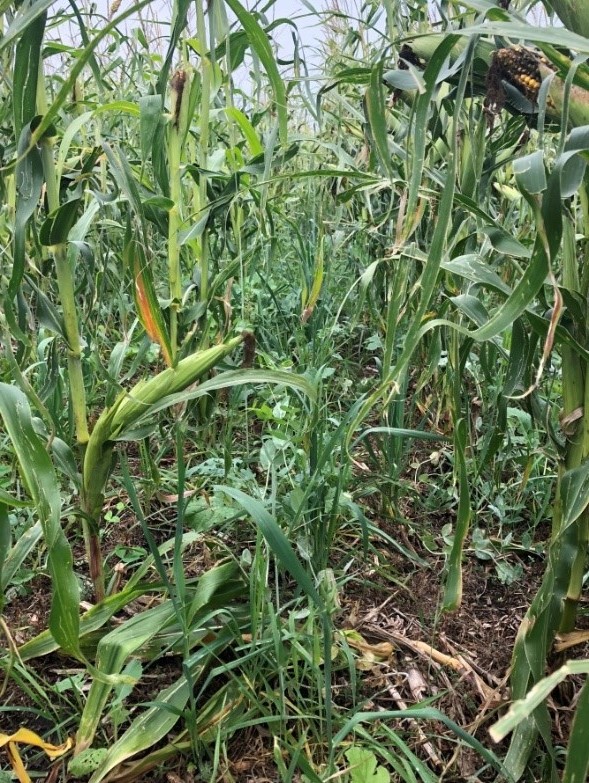
|
An interseeded cover crop grows between corn rows on Aug. 27, 2018. The cover crop species that seemed to perform well were oats, radish and field peas. Turnip coverage was sporadic, but when emerged, it was productive. |
We started a new rotational grazing treatment in 2018 that was designed to be different from other studies conducted in North America during the past 50 years. Most grazing system research was designed to create uniform, homogenous grazing patterns, and never overgrazing (heavy disturbance) or under grazing (light disturbance) within a unit.
The new treatment is a four-pasture modified twice-over, rest-rotation grazing strategy, with each pasture grazed at 1) take 75 percent, leave 25 percent - heavy use, 2) take 50 percent, leave 25 percent - full use, 3) take 25 percent, leave 75 percent - light use or 4) 12-plus months of rest – no use. This design also allows us to study regrowth and harvest efficiency of the cow.
The rotational grazing treatment allows us to compare three different grazing treatments that offer different grazing behavior and patterns, compared with a control. The three treatments are 1) patch spring-burn grazing (burn 25 percent of the pasture per year, with the entire pasture burned in four years), 2) patch spring plus summer burn (burn 12.5 percent of the pasture per year in the spring and 12.5 percent in the summer, with the entire pasture burned in four years), and 3) a four-pasture modified twice-over, rest-rotation grazing strategy (rotate the use patterns yearly to have high, mid, low and no disturbance in four years. Season long grazing is the control.
Because we have a twice-over rotation treatment, we were able to collect regrowth potential in the heavy-disturbance pasture between the rotations. The first rotation of the heavy-use pasture grazed cow-calf pairs from May 23 to June 22, and second rotation was from July 25-Sept. 10, or 33 days of recovery. The stocking rate for that heavy-use pasture was 0.5 acres/animal unit month and a stocking density at 1.2 acres/animal unit.
On the shallow loamy sites, grass regrowth was 73 percent higher than for vegetation that was not grazed (Table 1). The loamy ecological had a 94 percent recovery of grass production with 33 days’ rest.
Table 1. Regrowth of grazed vegetation and continued growth of non-grazed vegetation during a 33-day rest period (June 22 to July 25) on the heavy-disturbance pasture of the four-pasture modified twice-over, rest-rotation grazing strategy.

Interestingly, the cattle eat almost every plant species within a burn patch and in the heavy-use pasture. In the burned patches and heavy-grazed pastures, buckbrush and wormwood were grazed. In the burn patches, the cattle eat more of the buckbrush and much of the suckers, whereas with the heavy-grazed pasture, the cattle top the buckbrush, which should increase suckers in 2019. Other plants grazed were goldenrods, heath aster, wild licorice, sunflowers and Canada thistle.
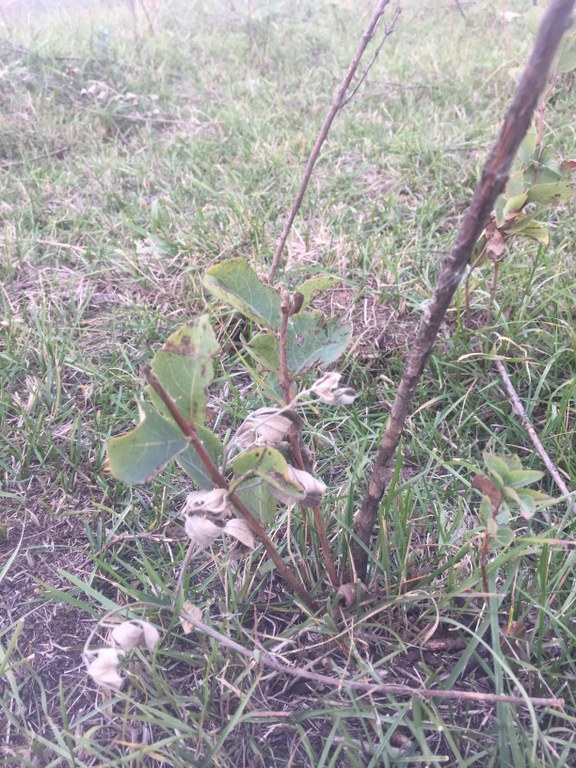
Grazed buckbrush in burned patch
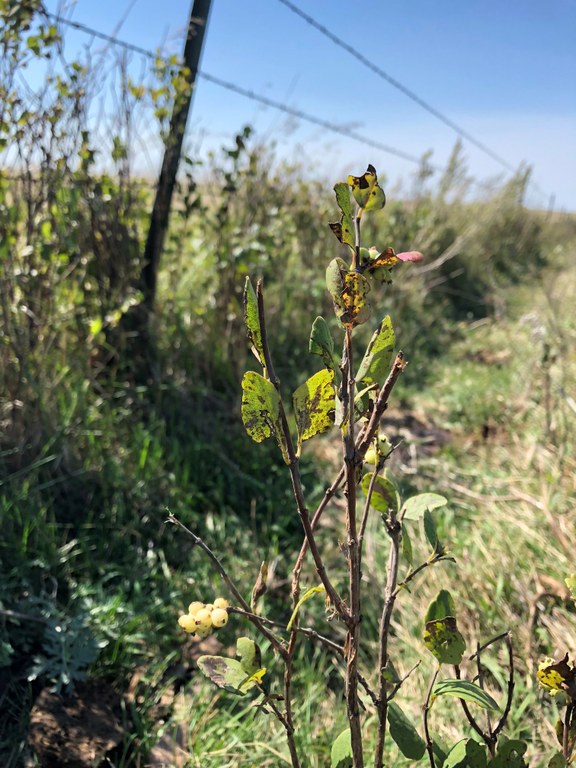
Grazed buckbrush in heavy-grazed pasture
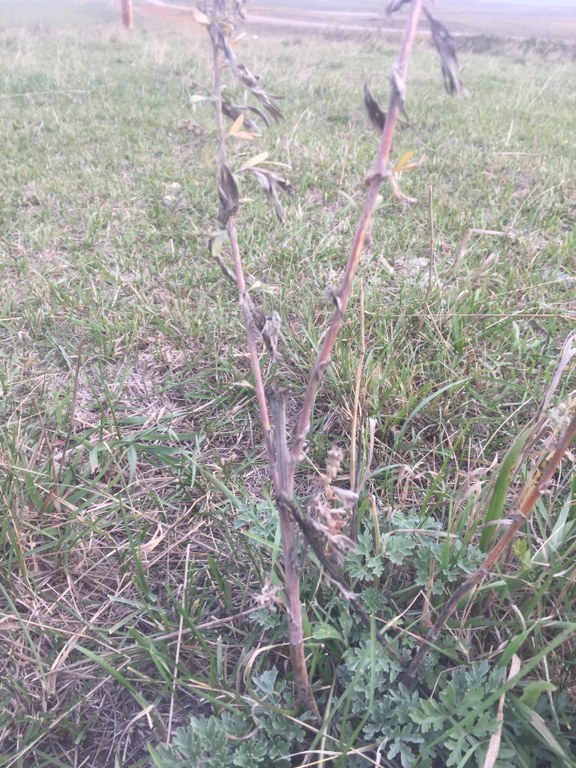
Grazed wormwood in burned patch
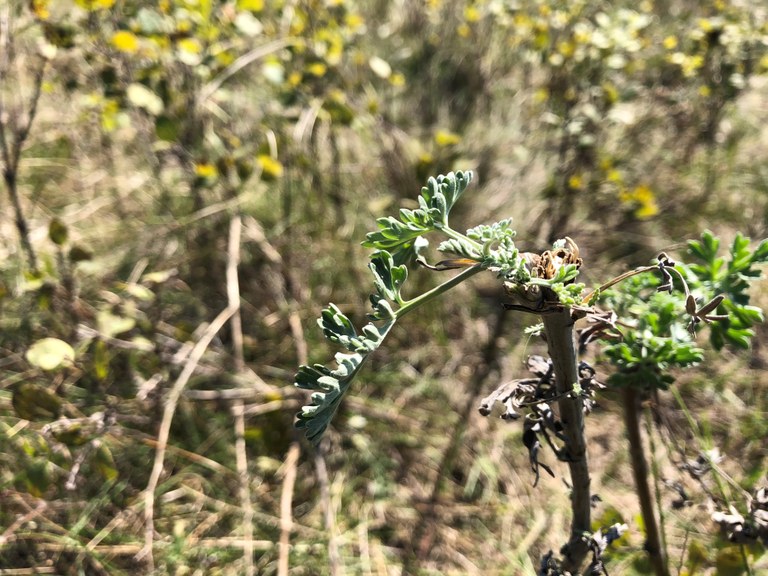
Grazed wormwood in heavy grazed pasture
Finally, the calves were weaned during the week of Oct. 15. The cows will go to Undi’s bale grazing trial or corn:cover crop study in mid-November, and a small group will graze Scott Alm’s swath corn grazing project in late October.
Calves will be sorted, with 96 steers going to Fargo and studied as part of a precision agriculture genome study by Alison Ward, Carl Dahlen and Undi. Thirty-six intact bull calves will go to Fargo for a feeding trial looking at impacts of sulfur (distillers grain vs. corn vs. a high-sulfur diet similar to levels found in distillers grain) on testicular development and fertility. All the baldy calves will have data collected by Lauren Hanna to study temperament of individuals based on dam and sire.
Well, I have gotten wordy and long – just like I talk! I hope your winter is mild, livestock are healthy and bred, and you find time to enjoy the outdoors with your family and friends. Until our next walk through the pasture, stay safe this winter and enjoy North Dakota’s beautiful fall season.
Photos by Kevin Sedivec
Winter Feeding Strategies for Beef Cattle
Erin Gaugler, Range Research Specialist, Central Grasslands Research Extension Center
This is the time of year when many of you turn your thoughts to winter feeding programs.
If you haven’t already, having a handle on the quantity and quality of your forage supply is a good idea. The challenge, depending on the class of cattle you are feeding, is to balance the ration with an appropriate amount of energy, protein and any mineral supplements.
High input costs for beef producers have challenged us to consider alternative feeding and management strategies to lower the cost of production and/or increase income to improve profitability. In a cow-calf production system, feed costs represent more than 60 percent of the total costs and are the largest determinant for profitability (Miller et al., 2001). The majority of feeding costs occur in the winter months, when grazing is limited and pastures are not productive. Thus, improved winter feeding strategies can impact producers’ profitability greatly.
Production agriculture is unique in that each operation has its own goals and resources. Therefore, no single approach to managing the herd through the winter is right for everyone. However, a plan should be formulated for each operation that makes the most sense and provides the best opportunity for profit.
The following discussion is designed to highlight alternative practices to winter animal confinement in a feedlot. While harsh winter weather conditions often result in the confinement of cattle, concentrated wintering sites may increase herd health and environmental concerns. We hope that alternative feeding strategies will allow producers to maintain herd health and condition while working toward the goals of their operation.
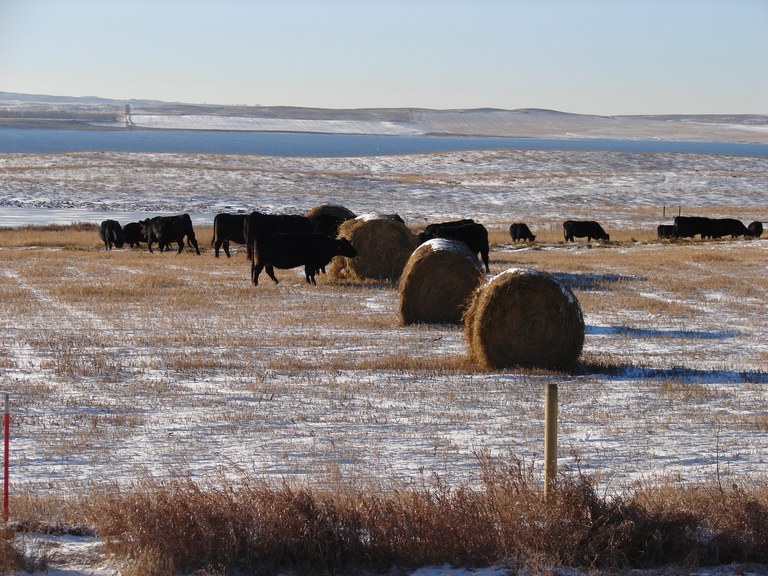
Photo by Rick Bohn
Custom Feeding
Wintering cattle away from home may be an option for producers who are concerned with labor and/or feed resources. Many feedlots throughout North Dakota are permitted to custom-feed cattle. While producers may realize labor savings, custom feeding is an added economic investment.
Extending the Grazing Season
Grazing periods can be extended by several months through the practice of bale grazing, swath and windrowed forage grazing, utilization of late-season annual forages, stockpiled pasture, crop residue and more. Through the management of these sites, late-season grazing has the potential to distribute manure across a larger area. Additionally, it can reduce feed waste (Berger and Volesky, 2006).
- Bale grazing: This strategy involves placing hay bales throughout a field (crop or hay land) and utilizes a temporary fence to allocate bales incrementally to the herd. Winter-grazed pastures have shown an increase in forage protein content and overall yield, when compared with fields that have had drylot manure and compost applied (Jungnitsch, 2008).
- Swath grazing: A summer-grown annual or perennial forage can be swathed prior to a killing frost for use as a late-season grazing option. When swathing, make sure the forage is on top of the stubble and that the rows are narrow and as deep as possible. This type of management will help reduce spoilage of the swathed forage.
- Deferred pastures: Pastures that have rested for most of the growing season, or longer, can be a good source for late fall or early winter grazing. Keep in mind that forage quality can be low and cattle may require supplementation to achieve desired performance.
- Crop residue: Corn and cereal residues also are viable fall and winter forage options. If you are considering this, or are wanting to work out a deal with your neighbor, evaluate your forage needs during harvest. Equipment selection at harvest can allow for the straw and chaff to be placed in windrows and bunches, which can increase the ability to use cereal crop residues. As with deferred pastures, keep in mind that forage quality can be low and cattle may require supplementation to achieve desired performance. In years when the growing season is dry, testing for nitrates also may be necessary. Snow accumulation may reduce forage consumption.
With consideration of resources, alternative winter feeding systems can be efficient and economically feasible for the cattle producer. Any goal or goals of the operation (improving herbage production, developing an integrated systems approach, reduction of labor, etc.) should be prioritized when preparing your winter feeding program. Other important factors to consider include access to windbreaks or shelterbelts, nutritional needs and access to water.
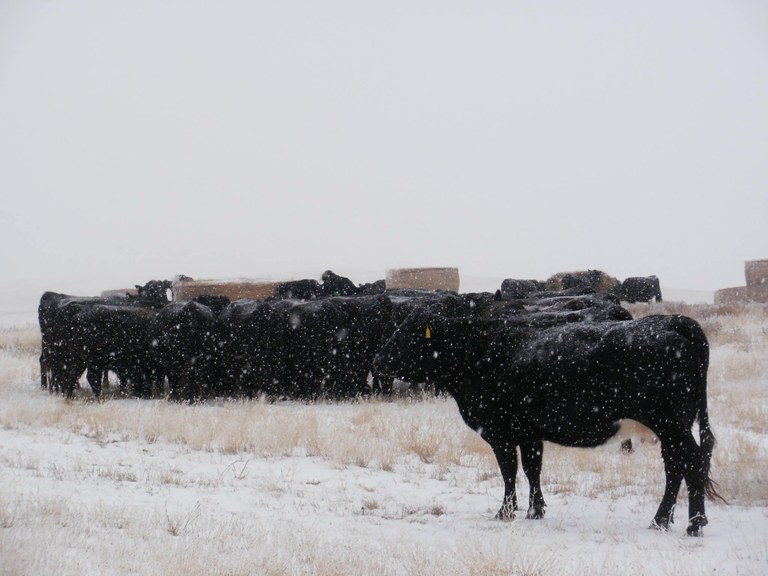
Photo by Erin Gaugler
Literature Cited
Berger, A.L. and J.D. Volesky. 2006. Windrow grazing. G1616. University of Nebraska-Lincoln Extension, Lincoln, Neb.
Jungnitsch, P.F. The Effect of Cattle Winter Feeding Systems on Soil Nutrients, Forage Growth, Animal Performance, and Economics. MSc. Thesis. University of Saskatchewan Department of Soil Science. May, 2008.
Miller, A.J., D.B. Faulkner, R. Knipe, D. Strohbehn, D.F. Parrett and L.L. Berger. 2001. Critical control points for profitability in the cow-calf enterprise. Prof. Anim. Sci. 17:295.
Preparing for a Championship (Calving) Season
Lisa Pederson, Extension Beef Quality Assurance Specialist, Central Grasslands Research Extension Center
We are in late October. Combines are running and hay is being hauled. Many producers in the northern Plains are weaning calves and pregnancy checking cows. On Saturdays, the NDSU Bison are thundering toward another national championship.
The spring calving season is not far off for our spring-calving herds. Now is a great time to prepare your cow herd and facilities for a championship calving season.
A Look Back
Did your 2018 calving season result in more losses than wins? Now (“the off-season”) is a good time to look back and review what went well, what could have gone better and what management practices can be implemented for a more successful 2019 calving season.
My Extension colleagues and I heard many accounts from producers and veterinarians about weak, sick calves. While some of this likely was due to an unusually cold and wet April, some was due to issues with cattle management and stewardship. I’m sharing my thoughts on some strategies producers can implement easily to improve on some of the management issues related to sick and weak calves.
Body Condition Score (BCS)
During the spring 2018 calving season, we heard many accounts of cow body condition scores being below a 4 at calving time. In fact, nearly every conversation I had with veterinarians about sick and weak calves included this observation.
What is BCS?
BCS is a standardized system designed to help cow-calf producers better manage energy reserves of their cows. It was developed to help producers better manage the nutrition of cows pre-calving, resulting in improved pregnancy rates.
The BCS uses a 1 to 9 scoring system, with a cow that scores a BCS of 1 being extremely thin and emaciated, and a cow with a BCS of 9 being extremely obese. Ideally, the cow herd should be in the 4 to 7 range year-round.
Guide to Body Condition Scoring
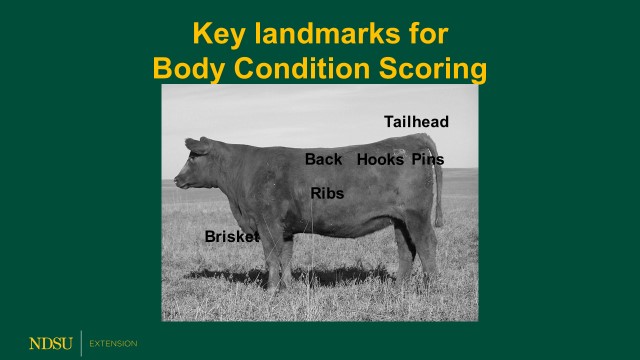
Examples of Descriptions of Body Condition Scores
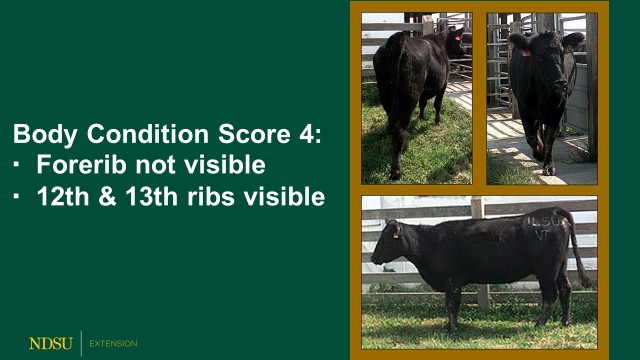
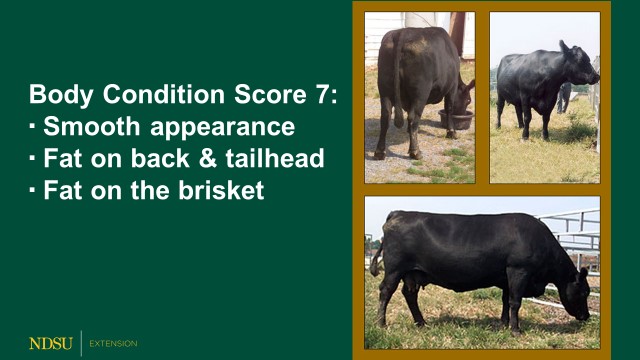
Why is BCS so important?
Scientific literature is abundant with data referencing cow herd body condition scores in relationship to colostrum quality, calf health (Fig. 1), calf survival, calf profitability, days to heat after calving, percentage of the herd pregnant in the first 21 days of the calving season, percentage of cows pregnant (Fig. 2 and Table 1) and herd profitability. Nearly all of the studies show that cows in a body condition score of 5 to 7 at calving time are more productive and more fertile, wean off healthier calves and are more profitable. Simply put, the single most important factor in a cow successfully rebreeding is her body condition score at calving.
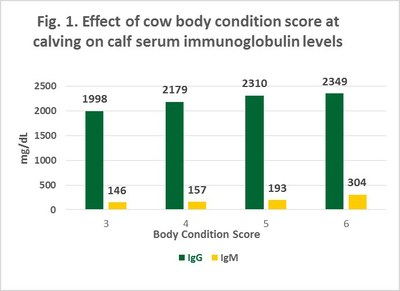
Odde (1997)
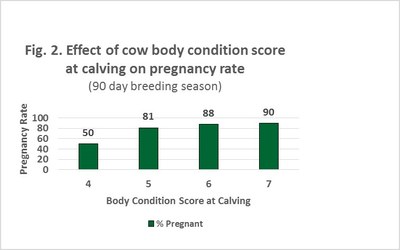
Selk et al. (1986)
Table 1. Relationship of body condition score at weaning and pregnancy rate for spring calving cows (Cherni, 1995: Padlock Ranch in Wyoming. Nine-year summary (1986-1994) 101,063 total observations.)
|
Body Condition Score |
|||||
|
|
<3 |
4 |
5 |
6 |
>6 |
|
Total Cattle |
3,415 |
23,811 |
37,970 |
26,213 |
9,654 |
|
% of Herd |
3.4 |
23.6 |
37.6 |
25.9 |
9.5 |
|
% Pregnant |
75.7 |
85.4 |
93.8 |
95.6 |
95.6 |
Looking to win a calving championship? Your cows will need energy!
Energy requirements for a cow are the highest after calving and the lowest at weaning. The energy cost of milk is particularly high. Increasing the BCS of a cow the first two to three months after calving is nearly impossible. However, increasing the BCS of a cow the first two months after weaning is quite easy.
This graph shows the energy needs and uses of a cow during the year, with calving on the left-hand side. About seven months after calving (weaning time), the energy needs of the cow are the lowest. At weaning time, cows efficiently convert energy and protein to muscle and fat.
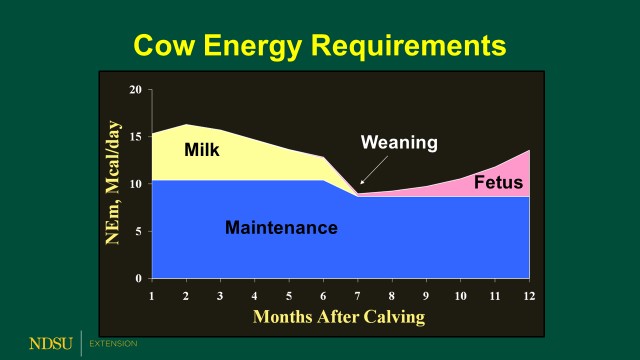
Literature and cow management guides cite three times when cow BCS should be evaluated: 1) weaning time; 2) 60 to 90 days prior to calving and 3) about 60 days prior to weaning.
Weaning and pregnancy check time: Weaning is a great time to evaluate your cow herd for BCS. Scoring your herd now gives you a basis of where the cows are and an estimate of nutritional resources the herd and individuals within the herd need to have a healthy, productive, profitable calf. Weaning also is the best time to add flesh to your cow’s condition.
60 to 90 days before calving: Herd BCS should be evaluated about 60 to 90 days prior to calving. This is in the second trimester of cow pregnancy. The second trimester is the most critical time to check BCS. This time frame allows sufficient time to add condition to cows and maintain or improve the quality of colostrum the female produces.
60 days before weaning: Late-summer cow condition evaluation allows for early weaning of calves or extra feed supplementation in the cases of thin cows due to decreasing pasture condition and drought.
Now is a good time to evaluate the condition of your cows. So get out and do it! And ask your Extension agent, veterinarian, nutritionist and/or neighbor to BCS your herd, too. They don’t see your cows every day and will give you a different perspective.
Winter Weather Nutrition
While increasing feed for our herd when the weather is extremely cold and windy is common sense, how much should we increase our feed? The critical temperature for cattle with heavy, dry hair is 18° F. When the temperature is colder than 18° F, we need to increase the energy in the diet.
A rule of thumb is that for each degree below 18 F, increase total digestible nutrients (TDN) in the diet 1 percent. For every 5 degrees below 18° F, increase TDN 1 pound.
And don’t forget about protection from the wind. Most of our farmsteads have shelter belts designed for far fewer cattle than most of our operations are running. Short-term investments in portable windbreaks and windbreaks made of bales are worth the cost and effort. For the long term, start planning tree row/shelter belt plantings for future herd size and expansion. These efforts will directly impact your herd health and feed bill.
Remember, the NDSU Bison football team starts planning for its next championship season the day after it wins the current one. Take a cue from the team’s success and start planning for a winning calving season by body condition scoring your cow herd now and again two to three months prior to calving.
Ask your Extension agent, herd veterinarian, nutritionist or friend to evaluate your herd’s body condition, too. Use the results of these efforts to determine where your herd needs to be nutritionally and in terms of body condition score at now, three months and at calving. These are progressive steps to a winning calving season.
Have a safe and productive fall. Go Bison!
Literature Cited
Encinias, A.M., and G. Lardy. 2000. Body Condition Scoring I: Managing Your Cowherd Through Body Condition Scoring. AS1026. North Dakota State University Extension. https://library.ndsu.edu/ir/bitstream/handle/10365/5343/as1026.pdf?sequence=1&isAllowed=y
Odde, K.G. 1997. Reproductive efficiency precalving nutrition and improving calf survival. Proc. Bovine Connection. p 86-92.
Rasby, R.J. 2014. Body Condition Scoring Beef Cows: A Tool for Managing the Nutrition Program for Beef Herds. EC281. University of Nebraska-Lincoln Extension.
Selk, G.E., R.P. Wettemann, K.S. Lusby and R.J. Rasby. 1986. The importance of body condition at calving on reproduction in beef cows. OSU Agric. Exp. Sta. Publ. 118:3163-3169.
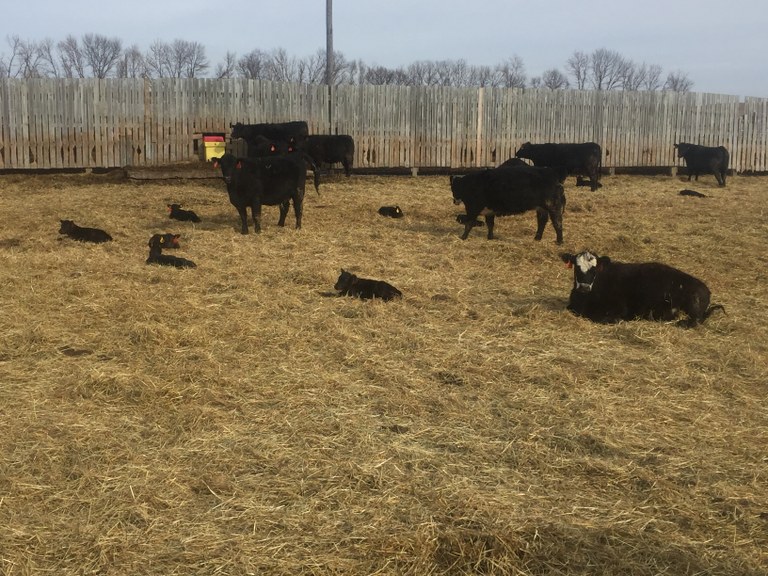
Photo by Kevin Sedivec
Central Grasslands Forum - Fall 2018 (Part 1)



